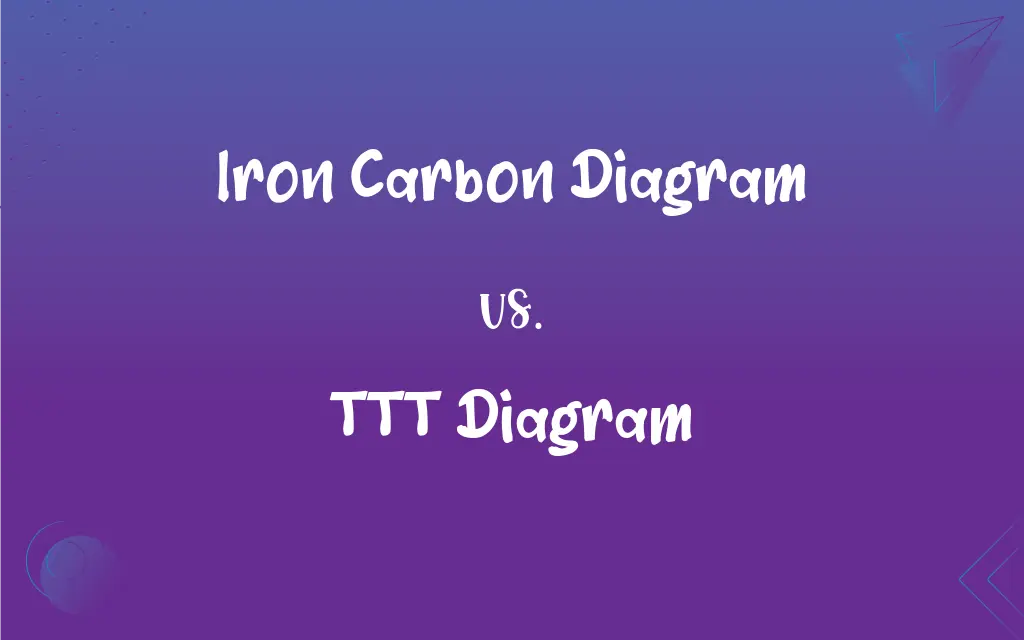Iron Carbon Diagram vs. TTT Diagram: What's the Difference?
Edited by Harlon Moss || By Janet White || Published on March 31, 2024
The iron-carbon diagram is a phase diagram showing the phases of steel and cast iron with different carbon content, while the TTT diagram (Time-Temperature-Transformation) illustrates the transformation of austenite to other phases over time.

Key Differences
The iron-carbon diagram and the TTT diagram are two essential tools in materials science for understanding the behavior of steel and cast iron. The iron-carbon diagram is a phase diagram that represents the phases present in steel and cast iron at different temperatures and carbon concentrations. The TTT diagram, on the other hand, is a kinetic diagram that shows the transformation of austenite to other phases such as pearlite, bainite, and martensite over time at different temperatures.
One key difference between the two diagrams is their focus. The iron-carbon diagram provides a static view of the equilibrium phases at different temperatures and carbon levels, while the TTT diagram provides a dynamic view of the transformation kinetics of austenite under non-equilibrium conditions. Additionally, the iron-carbon diagram is applicable to a wider range of carbon concentrations, whereas the TTT diagram is specifically focused on the transformation behavior of austenite in steel.
Both the iron-carbon diagram and the TTT diagram are indispensable for metallurgists and materials engineers in designing heat treatment processes and predicting the microstructure and properties of steel and cast iron. Understanding these diagrams is essential for optimizing the performance of these materials in various applications.
Comparison Chart
Focus
Equilibrium phases at different temperatures and carbon levels
Transformation kinetics of austenite over time
Application
Steel and cast iron
Mainly steel
ADVERTISEMENT
Information Provided
Phases present, eutectoid composition, solubility limits
Critical cooling rates, transformation start and finish times
Importance in Heat Treatment
Determines phases formed during slow cooling
Determines microstructure and properties after quenching
Representation
Temperature vs. carbon content
Time vs. temperature
Iron Carbon Diagram and TTT Diagram Definitions
Iron Carbon Diagram
A chart used to determine the phases present in steel and cast iron during slow cooling.
The iron-carbon diagram is essential for understanding the formation of pearlite in steel.
TTT Diagram
A kinetic diagram showing the transformation of austenite to other phases over time at different temperatures.
The TTT diagram is used to determine the cooling rate required to form martensite in steel.
ADVERTISEMENT
Iron Carbon Diagram
A diagram that illustrates the solubility limits of carbon in iron at different temperatures.
The iron-carbon diagram shows that the solubility of carbon in austenite decreases with temperature.
TTT Diagram
A chart that illustrates the critical cooling rates for avoiding undesired phases in steel.
Engineers consult the TTT diagram to avoid the formation of pearlite in high-carbon steel.
Iron Carbon Diagram
A graphical representation of the equilibrium phases in iron-carbon alloys.
The eutectoid point on the iron-carbon diagram indicates the composition of pearlite.
TTT Diagram
A graphical representation used to control the hardness and toughness of steel.
The TTT diagram is crucial for optimizing the heat treatment of steel for automotive applications.
Iron Carbon Diagram
A tool used to understand the effects of carbon content on the properties of iron alloys.
Engineers use the iron-carbon diagram to predict the hardness of steel after cooling.
TTT Diagram
A tool used to predict the final microstructure and properties of steel after heat treatment.
The TTT diagram helps metallurgists design quenching processes for tool steels.
Iron Carbon Diagram
A phase diagram showing the phases of steel and cast iron at different temperatures and carbon concentrations.
The iron-carbon diagram helps metallurgists design heat treatments for steel.
TTT Diagram
A diagram that shows the start and finish times of phase transformations in steel.
The TTT diagram indicates the time required for complete transformation of austenite to bainite.
FAQs
What is the iron-carbon diagram?
The iron-carbon diagram is a phase diagram that shows the phases of steel and cast iron at different temperatures and carbon concentrations.
Why is the eutectoid composition important in the iron-carbon diagram?
The eutectoid composition is important because it represents the carbon content at which the transformation of austenite to pearlite occurs at the lowest temperature.
What information can be obtained from a TTT diagram?
A TTT diagram provides information about the critical cooling rates, transformation start and finish times, and the final microstructure of steel after heat treatment.
What is the difference between the iron-carbon diagram and the TTT diagram?
The iron-carbon diagram focuses on the equilibrium phases at different temperatures and carbon levels, while the TTT diagram focuses on the transformation kinetics of austenite over time.
How is the iron-carbon diagram used in materials science?
The iron-carbon diagram is used to understand the equilibrium phases present in iron-carbon alloys and to design heat treatments for steel and cast iron.
How can the iron-carbon diagram help in predicting the hardness of steel?
The iron-carbon diagram can help predict the hardness of steel by indicating the phases formed during slow cooling, which determine the material's hardness.
How do cooling rates affect the transformation of austenite as shown in the TTT diagram?
Cooling rates affect the transformation of austenite by determining which phases are formed and the final properties of the steel.
How is the TTT diagram used in the heat treatment of steel?
The TTT diagram is used to design heat treatment processes that achieve the desired microstructure and properties in steel.
What is the TTT diagram?
The TTT diagram is a kinetic diagram that illustrates the transformation of austenite to other phases over time at different temperatures.
What is the significance of the solubility limits of carbon in the iron-carbon diagram?
The solubility limits of carbon are significant because they indicate the maximum amount of carbon that can be dissolved in iron at different temperatures.
How does the TTT diagram assist in avoiding undesired phases in steel?
The TTT diagram assists in avoiding undesired phases by indicating the cooling rates required to bypass certain phase transformations.
What is the significance of the austenite phase in the iron-carbon diagram?
The austenite phase is significant in the iron-carbon diagram as it is the high-temperature phase from which various transformations occur upon cooling.
What are the challenges in interpreting the iron-carbon diagram and the TTT diagram?
Challenges in interpreting the diagrams include understanding the complex phase relationships, accurately determining cooling rates, and applying the information to real-world heat treatment processes.
Can the TTT diagram be used for all types of steel?
The TTT diagram is primarily used for steels that undergo austenitic transformations, but it may not be applicable to all types of steel.
What is the role of the iron-carbon diagram in understanding the properties of cast iron?
The iron-carbon diagram helps in understanding the properties of cast iron by showing the phases present at different carbon levels and temperatures.
What are the limitations of the iron-carbon diagram?
The limitations of the iron-carbon diagram include its applicability only to equilibrium conditions and the simplification of complex phase relationships.
Can the iron-carbon diagram be used to predict the formation of pearlite in steel?
Yes, the iron-carbon diagram can be used to predict the formation of pearlite in steel by showing the temperature and carbon content at which pearlite forms.
How do metallurgists use the TTT diagram to design quenching processes?
Metallurgists use the TTT diagram to design quenching processes by selecting cooling rates that achieve the desired microstructure, such as martensite for hardness.
How do phase transformations in the TTT diagram affect the toughness of steel?
Phase transformations in the TTT diagram affect the toughness of steel by determining the microstructure, with certain phases like martensite increasing hardness but decreasing toughness.
How does the TTT diagram help in optimizing the heat treatment of steel for specific applications?
The TTT diagram helps in optimizing the heat treatment of steel by providing information on how to achieve the desired microstructure and properties for specific applications.
About Author
Written by
Janet WhiteJanet White has been an esteemed writer and blogger for Difference Wiki. Holding a Master's degree in Science and Medical Journalism from the prestigious Boston University, she has consistently demonstrated her expertise and passion for her field. When she's not immersed in her work, Janet relishes her time exercising, delving into a good book, and cherishing moments with friends and family.
Edited by
Harlon MossHarlon is a seasoned quality moderator and accomplished content writer for Difference Wiki. An alumnus of the prestigious University of California, he earned his degree in Computer Science. Leveraging his academic background, Harlon brings a meticulous and informed perspective to his work, ensuring content accuracy and excellence.































































